

Looking down at Bergteamet’s shotcreting robot (left). The side view (right) shows how a set of skis supports the automated system.
Nordic Suppliers Share Their Expertise
with the World
When it comes to mining and mineral processing, they have long experience working
with the hardest ores and deep mines
By Steve Fiscor, Editor-in-Chief


Many of these suppliers gathered during June at the Euro Mine Expo 2014 conference, which was held in Skellefteå, Sweden. In this part of Norrland, there are probably half a dozen major mines within 50 km of Skellefteå. While the town has diversified into other sectors by attracting different types of business, it can’t escape its role as a hub for miners in the region.
Mining in this region dates back three centuries and it’s an important part of the culture. For these suppliers, large and small, the mines in the region serve as proving grounds. For them, getting their equipment into the mines and plants is the first step. Letting the miners put the gear to work is the ultimate test. If they earn that Nordic stamp of approval, they know their equipment will work anywhere.
What follows is a digest of equipment and technology related items from the region—some of it gleaned from Euro Mine Expo, while other bits were brought to E&MJ’s attention by miners in the region.
Garpenberg Revises its Haulage Plan
A major project is under way at the Boliden-owned
Garpenberg mine in central Sweden to increase production
from 1.4 million metric tons per year (mt/y) to 2.5 million
mt/y by next year, and as a key part of that plan, the mine
decided to revise its haulage strategy.
Until now, the mine, which produces lead, zinc, silver and gold concentrates, has relied on general-purpose road trucks to haul ore to the surface. Starting January 1, these vehicles will be replaced by a fleet of Minetruck MT42 trucks developed and manufactured by Atlas Copco.
Local haulage contractor Långdahls Åkeri AB, which recently purchased four Minetruck MT42 trucks along with two Scooptram ST14 loaders, has been given the responsibility to optimize haulage operations at the mine for the next five years.
“This is a major investment for us,” said Elving Långdahl, owner and president of Långdahls. “The deciding factor was that our Boliden contract is a relatively long-term one, which means we can now replace the existing road trucks at the mine with trucks and loaders that have been designed and built for underground mining.”


Looking down at Bergteamet’s shotcreting robot (left). The side view (right) shows how a set of skis supports the automated system.
Långdahls has a lot of experience, transporting a wide variety of goods throughout the country. It has also trucked ore at Garpenberg before, but only on the surface between the mine and the processing plant. With its Boliden contract, Långdahls will now be “going underground” for the very first time.
“Naturally, trucks that are specially made for the job are more expensive than general-purpose trucks, but they are also much more effective,” Långdahl said. “By using the Atlas Copco equipment, we are confident that we will be able to make the haulage operation in the mine more efficient than ever before.
“The new trucks load 42 mt while the trucks that have been used up to now only take 28 mt,” Långdahl said. “That’s an improvement of about 40%, which will make a big difference to productivity.” Tire consumption is also an important cost factor. The tires on the Minetruck MT42 are adapted for the tough mining environment and they are expected to last much longer than standard road tires.
Another reason for choosing the Atlas Copco equipment is safety. “The cabins on the Minetruck MT42 are FOPS/ROPS approved, which means they are built to withstand rock falls and protect the drivers. In addition, the cabins are ergonomically designed and comfortable,” said Långdahl’s Lena Jensen, who will be in charge of health and safety for the 60 or so drivers who will be working in the mine.
During the latter part of this year, Atlas Copco will carry out a two-day training program for the Garpenberg haulage team at Långdahls. In addition to theoretical and practical training, selected drivers will also be given in-depth training on specific technology features such as the vehicles’ advanced control system.
Atlas Copco’s MT42 Gets Major Upgrade
The Minetruck MT42 was introduced to the market in 2009,
and has since been a faithful workhorse for mines around
the world. Now a range of new improvements has given this
42-mt capacity vehicle the means to beat its own high-productivity record. The most striking upgrades are a newly
designed box with an innovative tailgate solution and a new
engine alternative fulfilling engine emissions regulations.
The new box is almost completely made of high strength steel. It has the same physical envelope size as the previous model, but with a reduced dump height. The geometry is new with optimized internal plate angles, making it easier for material to be released and reducing the risk of carry-back.
In addition, the new box is equipped with an innovative tailgate, which acts as a spill guard. The tailgate folds down automatically behind the box before dumping without affecting either ground clearance or visibility for the rearview camera. The gate is hydraulically operated and the status of the gate’s position is presented for the operator on the display in the cabin.
The new engine alternative for Minetruck MT42 is the Cummins QSX15, which meets the exhaust emissions regulations of both The U.S. Environmental Protection Agency’s (EPA) Tier 4 final and European Union’s (EU) Stage IV. The engine installation is integrated into the control system of the truck, and the status of the diesel particulate filter and the diesel emission fluid tank is displayed in the cabin.

The MT42 can also be equipped with an optional electromagnetic retarder braking system. When hauling downhill, the retarder creates resistance and retardation. It provides wear-free braking resulting in long service life of the service brakes. Under the right conditions it can also allow for a higher speed, which means increased productivity. This solution is especially useful in applications with a high degree of downhill haulage with load, such as the haulage of waste rock fill in cut and fill applications.
“All of these new features make this truck outstanding in its class when it comes to productivity,” said Marcus Lundbergh, product manager at Atlas Copco. “It’s all about moving as much ore as possible, and with the upgraded Minetruck MT42, you fill the box quicker and without spillage, you tram a lot faster downhill with load and you empty the box faster.” Atlas Copco said it will be ready to start deliveries of the new Minetruck MT42 in 2015.
Rapidly Reinforcing Shafts
For several years now, Bergteamet has been developing a
shotcreting robot for lining raise bores and they displayed the
technology at Euro Mine Expo 2014. Bergteamet started as a
small contractor working with Boliden and LKAB before
acquiring Skanska RB, which helped the company grow internationally. Today, it’s recognized worldwide for its raise boring expertise. “We have a large fleet of raise boring
machines, a total of 22 rigs, and 12 of those are the large
diameter machines,” said Magnus Bergkvist, sales manager,
Bergteamet. “We provide all types of underground contracting services, and a lot of companies have jumbos, but the
raise boring machines are our crown jewels.”
Recognizing the need to quickly support a raise with a shotcrete lining, Bergteamet began developing an automated system about seven years ago. The system can shotcrete and reinforce the shaft without having miners in the shaft. The shotcreting robot is suspended from a cable and a winch slowly draws it upward (11 cm/min). A set of four pneumatically powered skis center and support the robot laterally using the shaft wall. Wet concrete and accelerator fluid are fed through the center of the robot using a series of hoses connected to a swivel on the nozzle at the bottom of the robot. Powered by a self-contained electric motor and gearbox, the nozzle rotates and sprays shotcrete on the shaft wall. The system can be used for raises up to 370 m deep with diameters measuring 2.5 m to 6.5 m. The current model was tested at Boliden’s Garpenberg mine, where it installed 150 mm of shotcrere lining in three 50-mm layers.
“The operator can see what’s happening in the shaft from four cameras mounted on the system,” Bergkvist said. “The shotcrete is mixed wet and pumped down, but the operator can adjust the amount of accelerator or the speed. In the beginning, we tried to use dry and semi-wet shotcrete with water added at the nozzle, but we could not get the right mixture.”
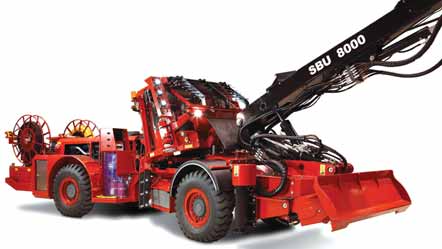
Depending on whether the system is used on the surface or underground, it can be set up in as little as two days. A surface application would require scaffolding, while an underground installation uses a roof plate to suspend the unit. Once the support system is in place, the operator lowers the robot down the shaft, centers it using the pneumatic cylinders (two on each leg), sets the speed on the winch, starts the pumps and slowly pulls it up.
“If a mine experiences a lot of rock movement, one big benefit of this system is that it can be rapidly deployed. If they can apply a 50-mm lining right away, it immediately protects the raise from rock movement,” said Peter Ohman, sales manager-underground contracting, Bergteamet.
The raise can be scanned before and after to determine the actual thickness of the lining. “We are developing a scanning system to measure the thickness while the unit is spraying the shotcrete, but it’s a dusty and difficult environment,” Bergkvist said.
“It’s a simple system, but the development process was complicated with a lot of variables. We designed it and it’s the only one using wet concrete to the best of my knowledge.” Bergkvist said. “We are now confident enough to actively promote it to the mining marketplace.”
Even though Bergteamet calls Skellefteå home, it has been exporting its expertise to underground hard rock miners around the world. It is one of the largest suppliers of underground services in Europe and the leading contractor in Scandinavia. Founded in 1999, Bergteamet has grown from five mining specialists to more than 400 today. The company has divided its practice into four divisions: raise boring, shaft and development work, tunneling, and equipment manufacturing. The Bergteamet MEC (Mining Equipment Construction) division designs and manufactures practically everything needed for underground operations.
“We have probably been the fastest growing contractor in the mining business,” said Bergkvist. “The growth has been mainly organic, working with mining companies to develop solutions, and through acquisitions.”
“One of the keys to our success is our main objective—to offer our customers total cost efficiency,” Bergkvist said. “To do so, we keep a close dialogue to ensure that we understand their needs, securing that we deliver the right product at the right time to the agreed-upon price.” He also attributes the company’s success to hiring the best people, using modern technology and continuously upgrading and expanding the company’s manufacturing equipment. Bergteamet, Bergkvist explained, has the people and the tools to get the job done.
Directional Core Drilling
Based in Melhus, Norway, Devico is currently providing directional drill services for a project in Colombia. This drilling
program is expected to shed further light on the mineral
resources in the region and hopefully increase confidence
levels for existing mineral resources. Initially, the proposed
drilling will focus on areas where sparse previous drilling has
intersected high gold grades. Directional drilling offers some
particular advantages from a limited number of deep-hole
platforms. They are:
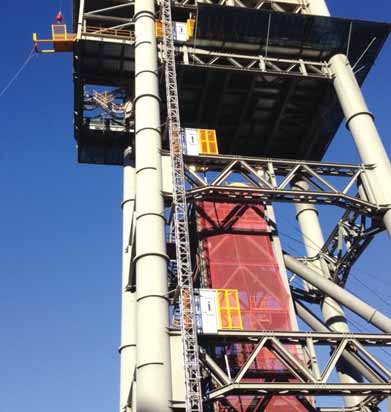
• Substantial time and cost savings due to reduced drill meterages and better drilling productivity relative to the number of conventionally drilled deep holes required to effect similar coverage; and
• The ability to better target key areas, control drill deviations and achieve better angles of attack on mineralized zones. Devico’s Directional Core drilling is a key element for the mine’s infill program. In this drilling method, several daughter holes are deviated (in inclination and azimuth) from different positions/elevations in a mother hole. The daughter holes can potentially be further deviated to produce more closely spaced pierce points in the mineralized zones.
Durable LEDs Illuminate
Mining Operations
Based in Finland, Nordic Lights develops
and manufactures LED, HID (Xenon),
and halogen work lights for the heavyduty on-road and off-road industry for
harsh working environments.
The company’s new Centaurus LED N4601 QD work light offers superior illumination with an evenly distributed light pattern. With a theoretical output of 9,600 lumens and an operational output of 6,000 lumens, the 85-watt lamp generates a strong light pattern. It is available in four light patterns: high beam, low beam, wide flood and flood. With a size of 138 x 124 x 13 mm and a weight of 2.9 kg, miners get a robust light filling its place on many applications.
The Centaurus is equipped with the Quake dampening system, which distributes vibrations and shocks uniformly. Since the dampening system can withstand more punishment, miners can attach larger lights to the same application.
Among other features, the lamp has an optically even? distribution of light pattern; demands minimum maintenance in its heavy-duty construction; has a long lifetime, multivoltage, replaceable lens; waterproof, extensive EMC; and is protected against load dumps, over voltage, reverse voltage and overheating.
Rugged Underground Utility Equipment
Jama Mining Machines had one of the largest stands at
Euro Mine Expo. For many years, the company has been
building equipment to make mining safer and more efficient.
Jama has developed an impressive line of scalers and concrete spraying machines. They had both of these units on
the stand along with a few other useful tools for underground miners.
“The strength of Jama Mining Machines is that we work closely with our customers,” said Anders Norberg, business development manager, Jama Mining Machines. “This equipment is not something that someone has dreamed up in an office somewhere; it has been developed in close cooperation with the mines. That’s why the machines are so dependable and well-respected.” Jama claims to have more than 90% market share for scalers in Sweden. The company is now beginning to export equipment in a structured manner.
The company’s 8000 series is the second generation and it has many improvements. The scalers and concrete spraying units (CSUs) are built on the same mining chassis. The 8000 series have PLC controls with Canbus connections and redundant loop wiring. The operators use a well-developed touchscreen that is easy to see and logically intuitive. A fault protection system notifies the operator if something goes wrong. The diesel power plant is Tier 4 Final compliant.
The CSU 8000B covers the full range of a tunnel up to 9 m high, 10 to 12 m at a time from one position depending on the height. Concrete is loaded from one end, and then the accelerator and compressed air are added to spray the concrete. The boom has been designed specifically for concrete spraying. Hydraulic cylinders extend the nozzle vertically and horizontally with variable speed oscillation. The concrete pump has a capacity of 16 to 24 m3/hr and a water-cooled compressor provides 12 to 14 m3 /min at 6 to 8 bar.
“The mines in Sweden are narrow so these machines are very good at maneuvering tight corners,” Norberg said. “In addition to the machine’s reliability and productivity, there has been quite a bit of emphasis on the operator’s cabin. This also contributes to the machine productivity indirectly.”
Jama’s Scaler Boom Unit (SBU) 8000B sits on the same chassis. It weighs 30,000 kg and has a turning radius of 5.2 m. The boom can scale as high as 9 m. All of the joints on the boom have expander bolts and plain bearings to withstand the force from the impact hammer. The machine also has four stabilizing jacks and a blade on the front.
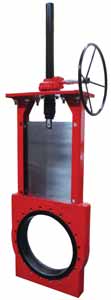
The machine has an aggressive, yet sleek profile. The operator’s cabin is well protected. However, both doors are equipped with gas springs for quick escape, just in case. The left entrance has a boot wash. The operator’s seat is air suspended. Most of the controls are mounted on the armrests and joysticks are used to maneuver the boom and steer the vehicle. The entire cab tilts back 13° for better vision and comfort during scaling operations.
When a rock fall is imminent, the operators activates the Danger Mode, which lowers the boom and jacks, lifts the dozer blade, and turns the cable and water reels on, then reverses the rig away from the area with warning lights rolling.
On the stand, Jama also had a scaling rig from 2007. “This machine has 9,000 hours total, and 4,000 working hours for this hammer. We brought this machine to not only show people the reliability, but also the difficult conditions under which it must perform.”
Jama also displayed its new BK008 mobile elevating working platform, which can be operated from the front-end loader’s cabin or the platform itself. “These have been available in the mining business for many years, but the regulations have changed recently,” Norberg said. “This platform has hydraulics that integrate between the platform and the machine. Once the platform is connected to the machine, by definition it becomes a mobile elevated work platform.”
The platform itself measures 2 x 2.3 m. The maximum lifting height is around 5 m and the lifting capacity ranges from 750 kg up to 1,500 kg. The unit has a canopy that can protect two miners. The floor can be constructed from galvanized steel grating or aluminum checker plate. It can be equipped with a hydraulically powered compressor, generator and concrete pump. It also has a rock bolt holder with a compartment for washers.
Industrial Lift Provides Maintenance
Access to Headframe
Skellefteå-based Alimak Hek installed an industrial lift at
Ernest Henry Mining (EHM) in northwest Queensland to provide operations and maintenance workers with access to four
levels of the headframe.
Following completion of its open-pit operations in 2011, EHM transitioned to underground mining and commenced trucking ore from the mine via a decline. In May 2012, EHM started construction to sink a new hoisting shaft as part of a $589 million expansion project to enable production at its new underground mine to double, and extend the life of the mine to at least 2024.
When commissioned in 2014, the 1,000-m deep shaft will increase production to 6 million mt/y, to produce more than 50,000 mt of copper and 70,000 oz of gold in concentrate.
The headframe, or winder tower, is a structural frame used to support the winding mechanism for the mine’s hoists, including hoist sheaves, cable drum, winder drive, and control and switch rooms. Providing access to the underground mining facility, these hoists are vital in the movement of ore out of the mine for processing.
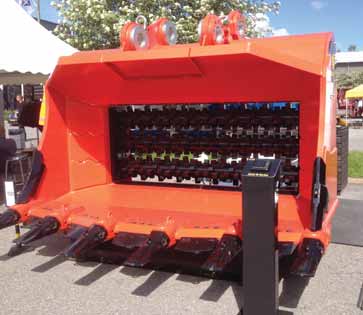
The incorporation of the Alimak industrial lift as part of the headframe has improved safety of operations for the mine site, providing a means of emergency access and evacuation, should an injury occur on the headframe. With a car size of 1.3 x 2.1 m, the Alimak SE 1,200-kg lift was selected to meet site safety requirements, with the extended car size able to accommodate the dimensions of a standard stretcher.
The Alimak industrial lift can be installed on almost any existing structure, due to its flexible and modular design. It is a very cost-effective solution, as the lift does not require a lift shaft or motor room like traditional traction elevators.
A New Slurry Knife Gate
The Finnish company Flowrox has a long history related to
valve technology. Everything began almost 40 years ago with
Larox Special Filters. These machines had to be suitable for
solids, slurries and especially for the abrasive media found in
mining processes. Conventional valves installed to the filters
required continuous maintenance and, as a result, a Larox
pinch valve was invented.
Soon these pinch valves became an integral part for these pressure filter systems. After the first application, the valves quickly became a success story for other applications. In 1993, Larox Flowsys was established to engineer and produce these valves. In 2011, the company name was changed to Flowrox, while Larox became associated with the filter business. The name changed but the commitment to quality remained the same. With almost 40 years of manufacturing flow control solutions for abrasive, corrosive and other demanding applications, Flowrox understands mineral processing and its requirements.
In addition to pinch valves, the product portfolio expanded to include peristaltic pumps, a range of knife-gate slurry valves and progressive cavity pumps. Flowrox recently also integrated automation flow control solutions to the product portfolio and the first product was introduced earlier this year; Flowrox Scaling Watch for imaging pipe scaling in real-time.
What separates Flowrox from other valve makers is the experience gained over decades in various heavy-duty applications. The core of the company’s valve, whether pinch valve or a knife gate valve, is the elastomer or rubber components, which are the key to its performance. Elastomers naturally have excellent wear resistance for mediums containing solids or abrasive substances.
In 2009, Flowrox launched Flowrox slurry knife-gate valves. This is a range of either wafer pattern, flanged or high-pressure knife-gate valves for process slurry isolation. However, the R&D process has been continuing in the background and Flowrox has carefully listened to what the customer has to say. Based on the direct feedback from the field, the structure of Flowrox knife-gate valve is now updated to fit the needs in heavy-duty processes even better.
Flowrox is now launching a new SKW valve that replaces the previous knife-gate model and represents a new generation slurry knife-gate valve. Also other launches to complete the new slurry knife-gate valve series are coming out later this year.
Flowrox SKW is especially designed for demanding and heavy industrial use, and due to its closing mechanism, it enables bidirectional flow of the slurry. The valve includes a new load distribution ring that is integrated to the ring sleeve. It prevents over compression and ensures the operation of the ring sleeve and gate and enables easy maintenance. Face-to-face dimension of the valve is according to industry standard.
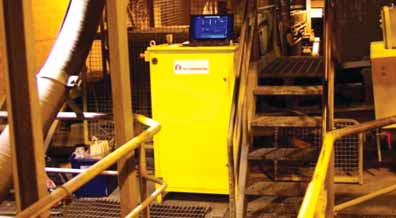
The cast body of the valve is now made as one casting as the previous model had two body halves that were bolted together. With this, the number of parts is reduced and there is no need for sealing between the body halves. This results in improved reliability and lifetime of the valve.
The SKW also features a universal tower design that allows any actuator to be easily connected to the tower structure. They can even be changed after installation. The tower is now bolted on the valve body from the top, which enables a very accurate and rigid mounting and ensures a good function of the valve regardless which type of an actuator is used.
These are just the main features as the list goes even further.
The main applications for Flowrox SKW valve are in processes where the medium includes solids or abrasive substances. Applications in mining and mineral processing are numerous and basically include mining slurries of almost any kind. As with other Flowrox products, the biggest advantages of SKW valve realize in demanding conditions and can be seen especially in the service-friendly design, reliable performance and long maintenance intervals.
A Primary Crushing Alternative
Allu had its M series soft-rock-crushing bucket on the stand
at Euro Mine Expo 2014. “This unit just completed three
years of testing,” said Fredrik Dromberg, business line manager-mining, Allu. “In the short period of time it has been on
the market, we have had great interest from mines around
world. This one is going to a diamond mine in Namibia.” The
M series is the mid-range unit of the six mining-class models
that span excavators from 50 to 160 mt, and wheel loaders
up to 90 mt (the Cat 992).
Allu began working with Chinese coal operations in 2002. The D series used in conjunction with a wheel loader became a popular replacement for mobile crushers in Chinese coal yards. “Word soon spread to the mines in Australia,” Dromberg said. “The problem was that the smallest wheel loader they were operating was a Cat 988 and we had nothing that big. That was when we made the decision to build a series of mining-class carriers, especially for soft-rock mining. Now there is more interest outside of the crushing such as screening applications for hardrock.” Other hard rock miners are using the buckets for road maintenance. Allu has also sold a number of units to coal harbors, which use them to break up frozen stockpiles.
The M series with a fine screening option work well for the Canadian oil sands, which are difficult. Allu has had no problem handling and processing the material, and the company gave an oil sands miner a unit to test for six weeks.
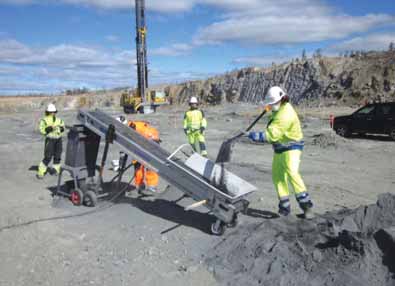
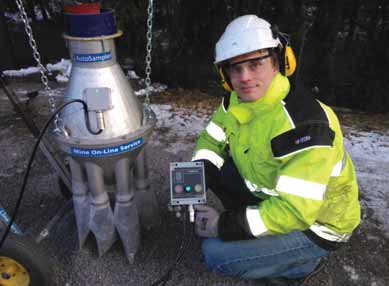
Miners are also considering the Allu crusher-buckets for raw gypsum. “They are looking the units to replace primary crushers in the mines,” Dromberg said. “They would then transport 0 x 300-mm raw gypsum directly to a secondary crusher with an automatic blending system.”
The Allu soft-rock-crushing buckets are built (welding and fabrication) in Finland. “The hydraulic motors and teeth are supplied by outside sources, but everything is manufactured in Finland,” Dromberg said. “There is not an ounce of normal steel in these units—everything is wear resistant—Hardox, Millox, Weldox, etc.” Designing the units, the Allu engineers calculate the needed strength and then they add a safety factor of 30%.
The units are equipped with sensors to measure bearing and hydraulic system conditions, and a mobile uplink system to collect and distribute the data. “If a mine has five buckets running, the service manager can see everything on one screen,” Dromberg said. “If a bearing heats up, he will receive an alarm and they can service the equipment.” Allu is developing a new system to accurately measure production. Similarly, the production manager could follow several buckets working around the mine.
When it comes to maintenance, the drums are the highwear items and miners have to replace them periodically. Different types of drum available for different applications. The frame is standardized, but Allu modifies the drum and uses whatever teeth the mine specifies. Each bucket has a certain level of customization.
“Everyone seems to be interested in saving energy these days,” Dromberg said. “Running these units will increase diesel consumption levels by 10% to 15%, but that’s a lot less energy than a mobile crusher consumes.”
Online Analysis
Innovative Mineral Analyzers and Engineering (IMA
Engineering) has successfully tested and subsequently delivered Fast Conveyor Analyzers (FCAs) for mines in Finland to
measure copper-zinc and copper-nickel ores. The FCA performs elemental analysis with XRF technology and it is capable of analyzing 0- to 400-mm size primary crushed ore in
varying belt load situations. With short analysis time, the FCA
continuously analyzes the ore on a conveyor and calculates
ore grade averages in batches of a few tons. The IMA FCA
analysis gives exact ore grade information to the concentrator a few hours before the ore enters the grinding mills. FCA
gives immediate feedback to loader operators in case they
have been loaded waste instead of ore to ore trucks. The provided analysis information will thus help in reducing waste
rock dilution and ore losses in mining and increase head
grade and recovery in concentrators.
Blasthole Sampling Studies
“If the sample is not right, nothing will save profit,” words of
wisdom from IMA Engineering, meaning that a representative
sample is the key for a successful mining operation. Mine
On-Line Service (MOLS) has been using IMA Engineering’s Orealyzer to conduct sampling studies at several Scandinavian mines. These studies have included blasthole sampling and reverse-circulation sampling for gold, copper, nickel and zinc mines. The latest extensive study was conducted
at Northland Resources Kaunisvaara iron mine in Sweden on
blasthole sampling.
MOLS has launched a new version of the novel Autosampler drill cuttings sampling and sample bagging device. The Autosampler can be mounted on any blasthole or R/C drill for splitting and collecting representative samples from the drill cuttings falling down from the drill’s dust collection system. The driller changes the sample bag using a remote control from the operator’s cabin. The standard Autosampler system holds eight elongated, transparent Softcore sample bags, which enable the geologist to log the samples without opening the bags.
 Scott Barker, president, Underground Rock Excavation. During July, Scott Barker was named president of Atlas Copco’s Underground Excavation Division. Headquartered in Örebro, Sweden, the group focuses on innovative product design and aftermarket support systems. Barker explained what he believes sets Atlas Copco apart from its competitors. “At the core, it is our people and our decentralized organization that enables them to excel,” Barker said. “We focus on our customers in every market and take decisions to meet their needs. You can see innovation in the way we work together with our customers and in the products we develop.” Supporting the underground hard rock business requires a commitment to safety. Barker explained that safety is the top concern for Atlas Copco and its products. “We strive for zero accidents in all that we do; nothing else is acceptable,” Barker said. “To reach that goal, we systematically identify risks and work to remove them through process and product designs. Employees are rewarded for identifying potentially hazardous situations so that we can work to eliminate the possibility for accidents. And, even when we are operating for long periods without accidents, we work with our safety programs to keep awareness high and drive further improvement.” Atlas Copco takes pride in the fact that they have application and service experts present in nearly every country. “Although methods vary from mine to mine, our network of specialists allows us to share what works best with each of our customers and adapt our product applications to their needs,” Barker said. “This knowledge-sharing drives higher levels of productivity in the mine operations, and our presence close to the mines enables quick feedback and support for them. Continuous improvement through quick action and response to feedback is what drives improved customer service. And our global footprint lets us keep our technical support and parts available close to our customers’ operations.” Barker pointed to three areas in Atlas Copco’s R&D program that excite him: automation, diesel-free vehicles and mechanical rock excavation. “And, we will lead the industry in all three areas,” Barker said. “Our automation products support machine operators to be more productive and safe, and fully autonomous mining is within sight. Alternative vehicle power solutions are developing very quickly, and it is possible now to have equipment operating more effectively on alternative power sources than on diesel engine power. We will lead the industry with this technology, providing more productive and cleaner work environments deep underground, and improving our environmental footprint overall. We are developing mechanical rock excavation methods to work effectively in hard rock applications, which will enable mines to target small mineral seams and reduce non-productive mining of waste rock.” Barker’s vision for Atlas Copco is to be the undisputed technology leader, providing innovative mining equipment and application expertise to drive highly effective, sustainable mining operations. |
 Jari Riihilahti, vice president, technology management and research, Metso. In an effort to bring the right technology, processes, machinery, and services to the mining and minerals business, Metso has been linking up its customers and others to search for new approaches to confront future challenges. “Metso is well-known for its extensive service offering. Over time, we have learned to design plants that are easier to build and manage with the highest quality in mind,” said Jari Riihilahti, vice president, technology management and research for Metso’s mining and construction division. “Safety comes first and it goes hand-in-hand with services. We offer professional services during construction, startup and commissioning, and we also look after the plant throughout its life.” Riihilahti has an extensive R&D background with Metso and its predecessor companies. In 2007, he moved from Metso’s automation business to Metso’s minerals and aggregates business. Metso has the largest service network of its kind with 50 services center spread around the globe and they are establishing more. “The service centers have to be located close to the customers,” Riihilahti said. “Going beyond the traditional maintenance services that all companies offer, Metso is focused on performance solutions. A good example would be the company’s life-cycle service agreements, where the company bundles service with a long-term commitment. The object is to cut costs and increase productivity for the mines.” These life-cycle service contracts encompass ongoing performance and maintenance services with respect to all of the equipment in the processing area. As part of the agreement, Metso becomes fully aligned with its customer's production targets and it is paid, for example, on a costper-ton of ore processed basis. The service contract can apply to all mechanical maintenance in the processing area, not just the equipment supplied by Metso. Riihilahti acknowledged that water and energy are two of the biggest concerns facing mill operators. “These topics are always on our minds at Metso and this challenge is global, not just in the developing world,” Riihilahti said. “Energy availability and energy costs are a primary consideration for every operation. Some locations have too much water, while others do not have enough.” 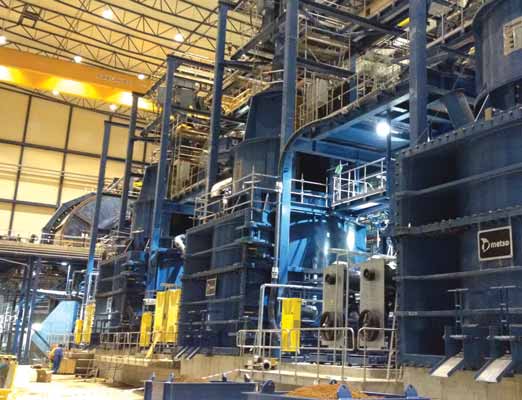 The globally recognized Metso VERTIMILL vertical grinding mill provides high energy efficiency and low total cost of ownership. Overall, the less water and energy used to process minerals is a winning approach, Riihilahti explained. “We are using technology to develop new processes with these goals in mind,” Riihilahti said. “Declining ore grades also means that we are processing more rock to produce the same amount of metal. We are searching for better ways to handle increasing volumes and liberate metals for the next generation.” On the other hand, one must not forget about existing plants, Riihilahti explained. “Some of the new technologies and services we have developed can also be applied to existing operations to conserve water and reduce energy consumption, which directly impacts the plant’s bottom line,” Riihilahti said. “These optimization services can reduce energy demand by 30% to 40% depending on the efficiency of the plant.” Looking toward the future of R&D in minerals processing, Riihilahti said he gets excited about the strategic relationships being formed in this area. He pointed to the new five-year agreement that Metso recently struck with leading mining companies in Chile and the University of Queensland’s JKTech division to develop next-generation technologies and services for energy-efficient minerals concentration. “When the leading miners and world-class service centers join forces, the combination will generate some great ideas,” Riihilahti said. “The longer five-year timeframe is also ideal for research programs.” Metso and JKTech SPA will cooperate with the leading Chilean mining companies to develop Chile as a regional innovation hub for minerals processing. The research work will be conducted at existing mines in Chile with a very clear focus on strategic needs. The program’s four principal research themes are primary grinding, ball mill grinding, classification and coarse particle flotation; the main operational targets are productivity, energy and water efficiency. (See Processing Solutions, E&MJ September 2014, p. 118, for full details) “The challenges we face as an industry are common,” Riihilahti said. “So far, the development has been incremental, but now we are looking to make step changes. The key to making these step changes is the relationships with the customer and the cooperation with these research organizations.” |